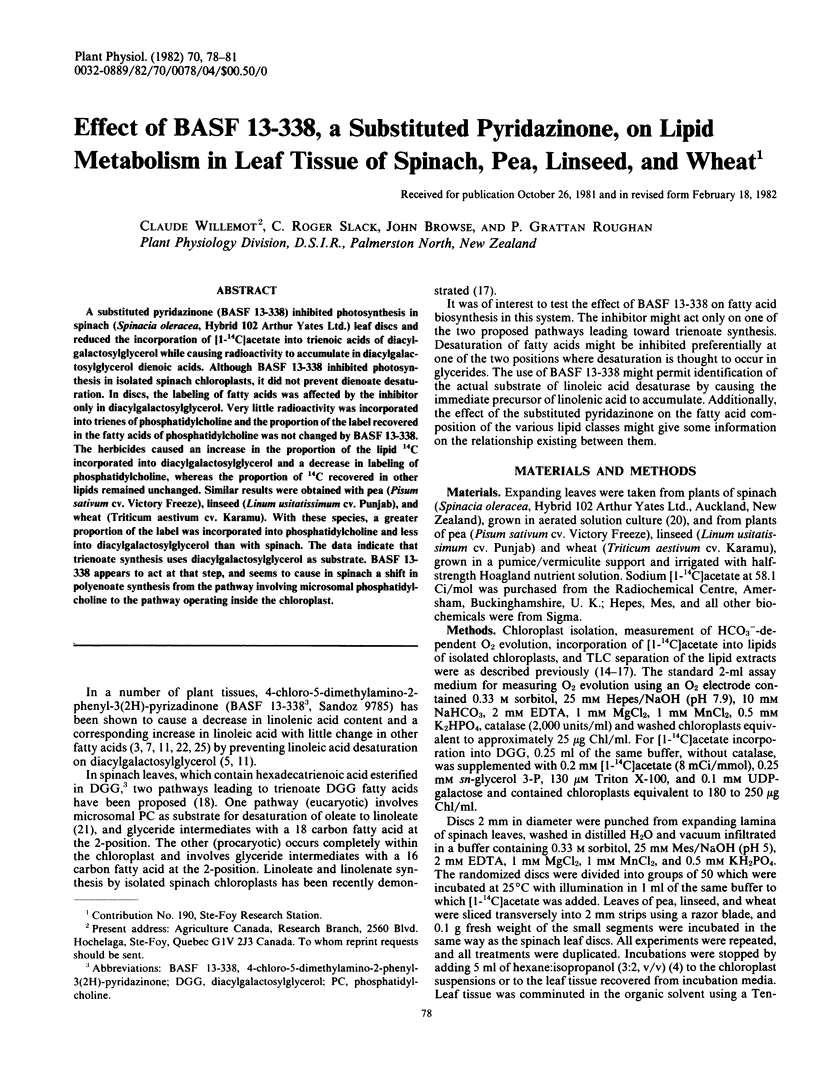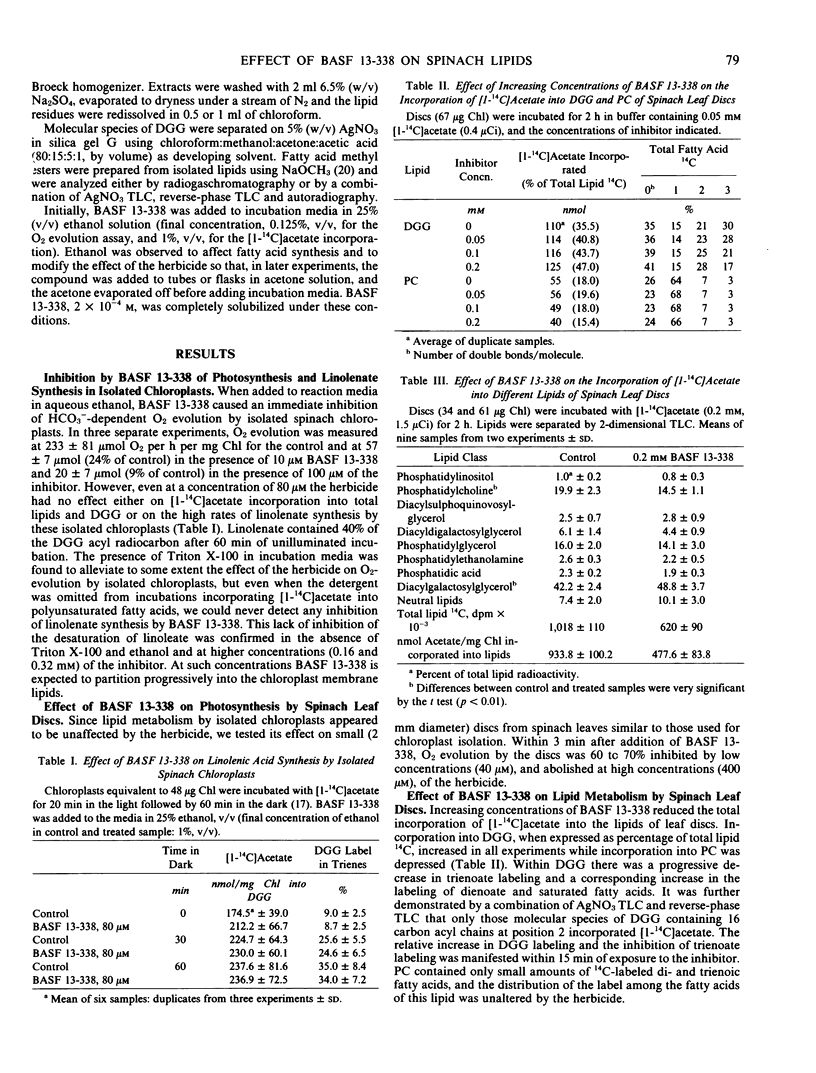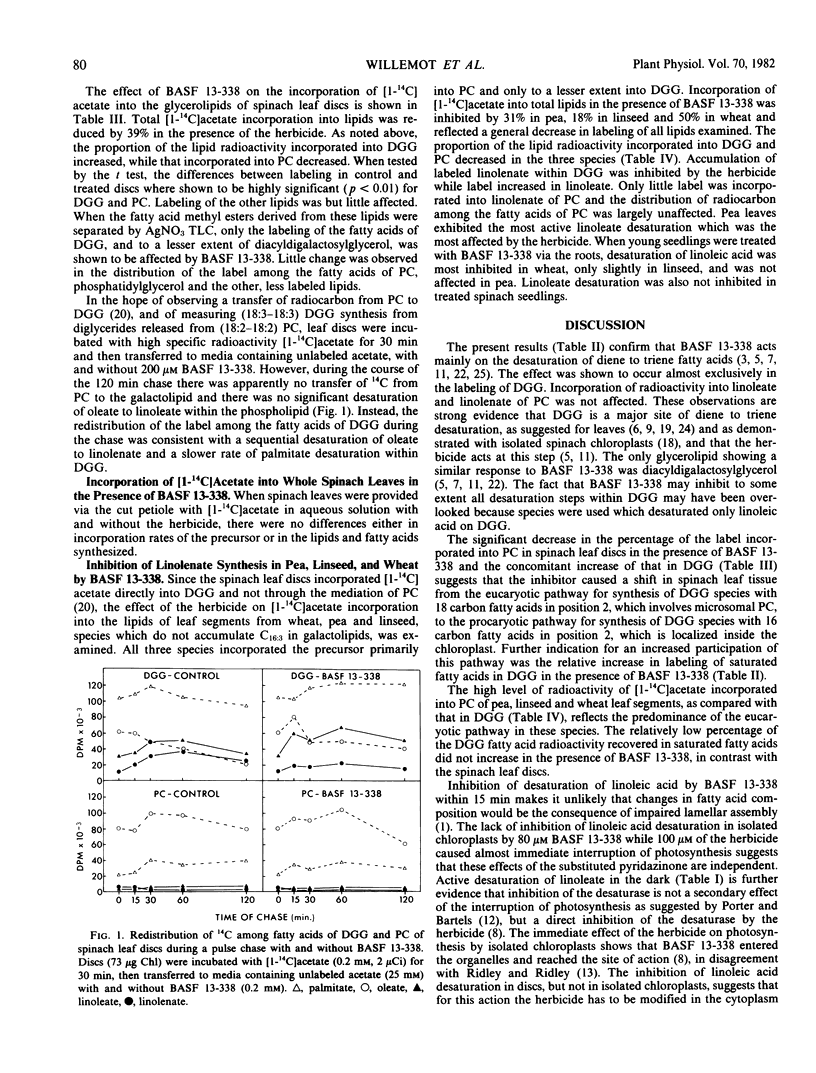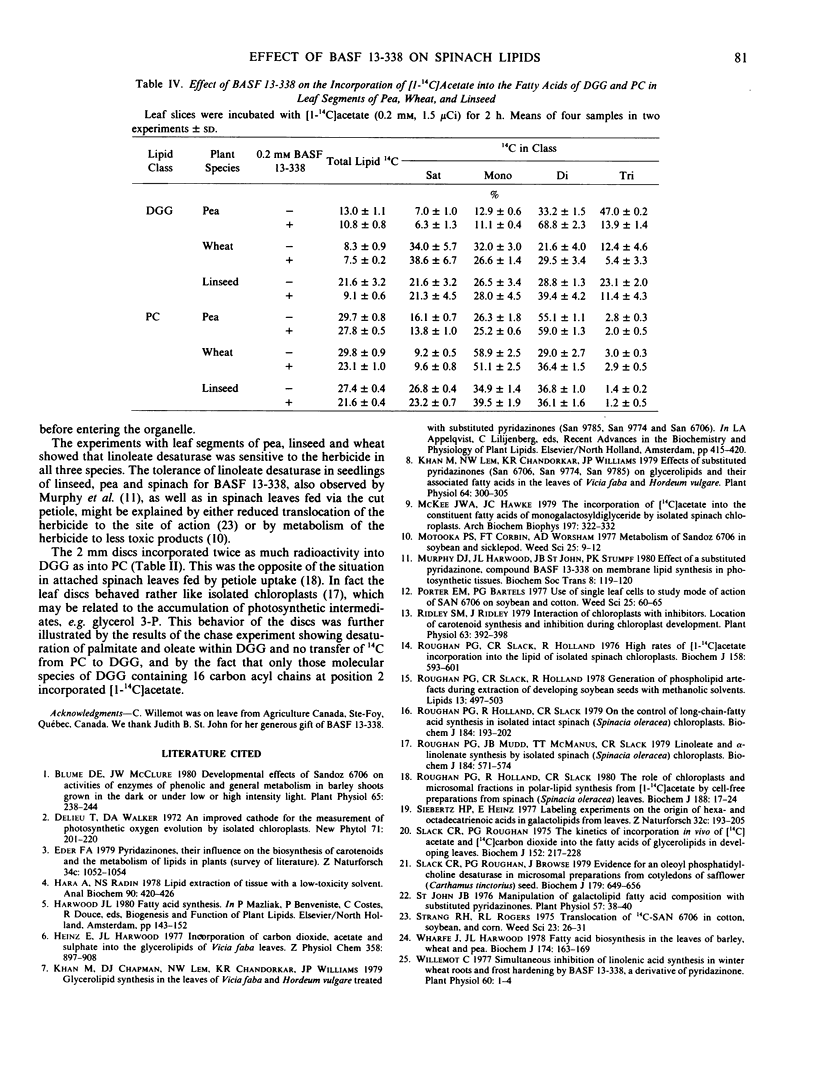Abstract
A substituted pyridazinone (BASF 13-338) inhibited photosynthesis in spinach (Spinacia oleracea, Hybrid 102 Arthur Yates Ltd.) leaf discs and reduced the incorporation of [1-14C]acetate into trienoic acids of diacylgalactosylglycerol while causing radioactivity to accumulate in diacylgalac-tosylglycerol dienoic acids. Although BASF 13-338 inhibited photosynthesis in isolated spinach chloroplasts, it did not prevent dienoate desaturation. In discs, the labeling of fatty acids was affected by the inhibitor only in diacylgalactosylglycerol. Very little radioactivity was incorporated into trienes of phosphatidylcholine and the proportion of the label recovered in the fatty acids of phosphatidylcholine was not changed by BASF 13-338. The herbicides caused an increase in the proportion of the lipid 14C incorporated into diacylgalactosylglycerol and a decrease in labeling of phosphatidylcholine, whereas the proportion of 14C recovered in other lipids remained unchanged. Similar results were obtained with pea (Pisum sativum cv. Victory Freeze), linseed (Linum usitatissimum cv. Punjab), and wheat (Triticum aestivum cv. Karamu). With these species, a greater proportion of the label was incorporated into phosphatidylcholine and less into diacylgalactosylglycerol than with spinach. The data indicate that trienoate synthesis uses diacylgalactosylglycerol as substrate. BASF 13-338 appears to act at that step, and seems to cause in spinach a shift in polyenoate synthesis from the pathway involving microsomal phosphatidylcholine to the pathway operating inside the chloroplast.
Full text
PDF



Selected References
These references are in PubMed. This may not be the complete list of references from this article.
- Blume D. E., McClure J. W. Developmental Effects of Sandoz 6706 on Activities of Enzymes of Phenolic and General Metabolism in Barley Shoots Grown in the Dark or under Low or High Intensity Light. Plant Physiol. 1980 Feb;65(2):238–244. doi: 10.1104/pp.65.2.238. [DOI] [PMC free article] [PubMed] [Google Scholar]
- Hara A., Radin N. S. Lipid extraction of tissues with a low-toxicity solvent. Anal Biochem. 1978 Oct 1;90(1):420–426. doi: 10.1016/0003-2697(78)90046-5. [DOI] [PubMed] [Google Scholar]
- Heinz E., Harwood J. L. Incorporation of carbon dioxide, acetate and sulphate into the glycerolipids of Vicia faba leaves. Hoppe Seylers Z Physiol Chem. 1977 Jul;358(7):897–908. doi: 10.1515/bchm2.1977.358.2.897. [DOI] [PubMed] [Google Scholar]
- John J. B. Manipulation of galactolipid Fatty Acid composition with substituted pyridazinones. Plant Physiol. 1976 Jan;57(1):38–40. doi: 10.1104/pp.57.1.38. [DOI] [PMC free article] [PubMed] [Google Scholar]
- Khan M. U., Lem N. W., Chandorkar K. R., Williams J. P. Effects of Substituted Pyridazinones (San 6706, San 9774, San 9785) on Glycerolipids and Their Associated Fatty Acids in the Leaves of Vicia faba and Hordeum vulgare. Plant Physiol. 1979 Aug;64(2):300–305. doi: 10.1104/pp.64.2.300. [DOI] [PMC free article] [PubMed] [Google Scholar]
- McKee J. W., Hawke J. C. The incorporation of [14C]acetate into the constituent fatty acids of monogalactosyldiglyceride by isolated spinach chloroplasts. Arch Biochem Biophys. 1979 Oct 1;197(1):322–332. doi: 10.1016/0003-9861(79)90252-2. [DOI] [PubMed] [Google Scholar]
- Murphy D. J., Harwood J. L., St John J. B., Stumpf P. K. Effect of a substituted pyridazinone, compound BASF 13-338 on membrane lipid synthesis in photosynthetic tissues [proceedings]. Biochem Soc Trans. 1980 Feb;8(1):119–120. doi: 10.1042/bst0080119. [DOI] [PubMed] [Google Scholar]
- Ridley S. M., Ridley J. Interaction of Chloroplasts with Inhibitors: Location of Carotenoid Synthesis and Inhibition during Chloroplast Development. Plant Physiol. 1979 Feb;63(2):392–398. doi: 10.1104/pp.63.2.392. [DOI] [PMC free article] [PubMed] [Google Scholar]
- Roughan P. G., Holland R., Slack C. R. On the control of long-chain-fatty acid synthesis in isolated intact spinach (Spinacia oleracea) chloroplasts. Biochem J. 1979 Nov 15;184(2):193–202. doi: 10.1042/bj1840193. [DOI] [PMC free article] [PubMed] [Google Scholar]
- Roughan P. G., Holland R., Slack C. R. The role of chloroplasts and microsomal fractions in polar-lipid synthesis from [1-14C]acetate by cell-free preparations from spinach (Spinacia oleracea) leaves. Biochem J. 1980 Apr 15;188(1):17–24. doi: 10.1042/bj1880017. [DOI] [PMC free article] [PubMed] [Google Scholar]
- Roughan P. G., Mudd J. B., McManus T. T., Slack C. R. Linoleate and alpha-linolenate synthesis by isolated spinach (Spinacia oleracea) chloroplasts. Biochem J. 1979 Dec 15;184(3):571–574. doi: 10.1042/bj1840571. [DOI] [PMC free article] [PubMed] [Google Scholar]
- Roughan P. G., Slack C. R., Holland R. High rates of [1-14C]acetate incorporation into the lipid of isolated spinach chloroplasts. Biochem J. 1976 Sep 15;158(3):593–601. doi: 10.1042/bj1580593. [DOI] [PMC free article] [PubMed] [Google Scholar]
- Slack C. R., Roughan P. G., Browse J. Evidence for an oleoyl phosphatidylcholine desaturase in microsomal preparations from cotyledons of safflower (Carthamus tinctorius) seed. Biochem J. 1979 Jun 1;179(3):649–656. doi: 10.1042/bj1790649. [DOI] [PMC free article] [PubMed] [Google Scholar]
- Slack C. R., Roughan P. G. The kinetics of incorporation in vivo of (14C)acetate and (14C)carbon dioxide into the fatty acids of glycerolipids in developing leaves. Biochem J. 1975 Nov;152(2):217–228. doi: 10.1042/bj1520217. [DOI] [PMC free article] [PubMed] [Google Scholar]
- Wharfe J., Harwood J. L. Fatty acid biosynthesis in the leaves of barley, wheat and pea. Biochem J. 1978 Jul 15;174(1):163–169. doi: 10.1042/bj1740163. [DOI] [PMC free article] [PubMed] [Google Scholar]


